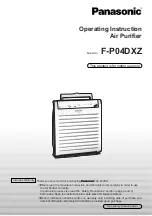
10
GB
D
F
I
NL
E
SW
P
4. Space required around unit
[Fig. 4.0.1] (P.2)
<A> With the inlet surface facing the wall
<B> With the outlet surface facing the wall
<C> Relation of units for multiple unit installation
A
Service panel
B
Inlet surface
C
Outlet surface
D
Air outlet guide (Optional part)
E
Please set the unit that the inlet air and the outlet air are not influenced.
(1) Basic space required (in case of <A>)
A space of at least 150 mm is necessary at the inlet surface. Taking servicing, etc.
at the service panel side, a space of at least 500 mm should be provided and outlet
side should be opened.
(2) Basic space required (in case of <B>)
A space of at least 150 mm (right inlet surface) and 500 mm (outlet surface) is
necessary.
The service panel side and inlet surface should be opened.
(3) When Installing multiple units
Space required as shown in Fig <C>.
5. Lifting method and weight of product
[Fig. 5.0.1] (P.3)
Caution:
•
Be very careful to carry product.
- Do not have only one person to carry product if it is more than 20 kg.
- PP bands are used to pack some products. Do not use them as a mean for transportation because they are dangerous.
- Do not touch heat exchanger fins with your bare hands. Otherwise you may get a cut in your hands.
- Tear plastic packaging bag and scrap it so that children cannot play with it. Otherwise plastic packaging bag may suffocate children to death.
- When carrying in outdoor unit, be sure to support it at four points. Carrying in and lifting with 3-point support may make outdoor unit unstable, resulting in a fall of it.
•
Use pads properly to prevent the scratching of external panel caused by contact with sling.
6. Installation of unit
6.1. Installation
[Fig. 6.1.1] (P.3)
A
M8 anchor bolt procured at the site.
B
Corner is not seated.
[Fig. 6.1.2] (P.3)
A
4-10
×
20 Holes
For mounting anchor bolt M8 (Field supply)
B
Bolt mounting pitch
•
Fix unit tightly with bolts so that unit will not fall down due to earthquake or
gust.
•
Use concrete or angle for foundation of unit.
•
Vibration may be transmitted to the installation section and noise and vibration
may be generated from the floor and walls, depending on the installation con-
ditions. Therefore, provide ample vibrationproofing (cushion pads, cushion
frame, etc.).
•
Be sure that the corners are firmly seated. If the corners are not firmly seated,
the installation feet may be bent.
Warning:
•
Be sure to install unit in a place strong enough to withstand its weight.
Any lack of strength may cause unit to fall down, resulting in a personal
injury.
•
Have installation work in order to protect against a strong wind and earth-
quake.
Any installation deficiency may cause unit to fall down, resulting in a
personal injury.
When building the foundation, give full attention to the floor strength, drain water
disposal <during operation, drain water flows out of the unit>, and piping and wir-
ing routes.
6.2. Connecting direction for refrigerant
pipe
[Fig.6.2.1] (P.3)
A
Service panel
B
Refrigerant pipe
7. Refrigerant piping installation
This piping work must be done in accordance with the installation manuals for
indoor unit.
•
Check table below for piping connection of outdoor unit.
2
Commercially available piping often contains dust and other materials. Always
blow it clean with a dry inert gas.
3
Use care to prevent dust, water or other contaminants from entering the piping
during installation.
4
Reduce the number of bending portions as much as possible, and make bend-
ing radius as big as possible.
5
Always observe the restrictions on the refrigerant piping (such as rated length,
the difference between high/low pressures, and piping diameter). Failure to do
so can result in equipment failure or a decline in heating/cooling performance.
6
Never use refrigerant to perform an air purge. Always evacuate using a vacuum
pump.
7
Always insulate the piping properly. Insufficient insulation will result in a de-
cline in heating/cooling performance, water drops from condensation and other
such problems.
8
When connecting the refrigerant piping, make sure the ball valve of the out-
door unit is completely closed (the factory setting) and do not operate it until
the refrigerant piping for the outdoor and indoor units has been connected, a
refrigerant leakage test has been performed and the evacuation process has
been completed.
Field piping connection method
Liquid pipe: flare type, Gas pipe: flange type (brazing)
Model
PUH-8, 10
Warning:
Always use extreme care to prevent the refrigerant gas (R22) from leaking
while using fire or flame. If the refrigerant gas comes in contact with the
flame from any source, such as a gas stove, it breaks down and generates a
poisonous gas which can cause gas poisoning. Never weld in an unventilated
room. Always conduct an inspection for gas leakage after installation of the
refrigerant piping has been completed.
7.1. Caution
1
Use the following materials for refrigeration piping.
•
Material: Use refrigerant piping made of phosphorus deoxidized copper. In
addition, be sure that the inner and outer surfaces of the pipes are clean
and free of hazardous sulphur, oxides, dust/dirt, shaving particles, oils,
moisture, or any other contaminant.
PUH-8
PUH-10
200
208
Product weight (kg)
WT05109X03_gb.p65
6/8/09, 11:33 AM
10
Содержание 10YKA
Страница 31: ......











































